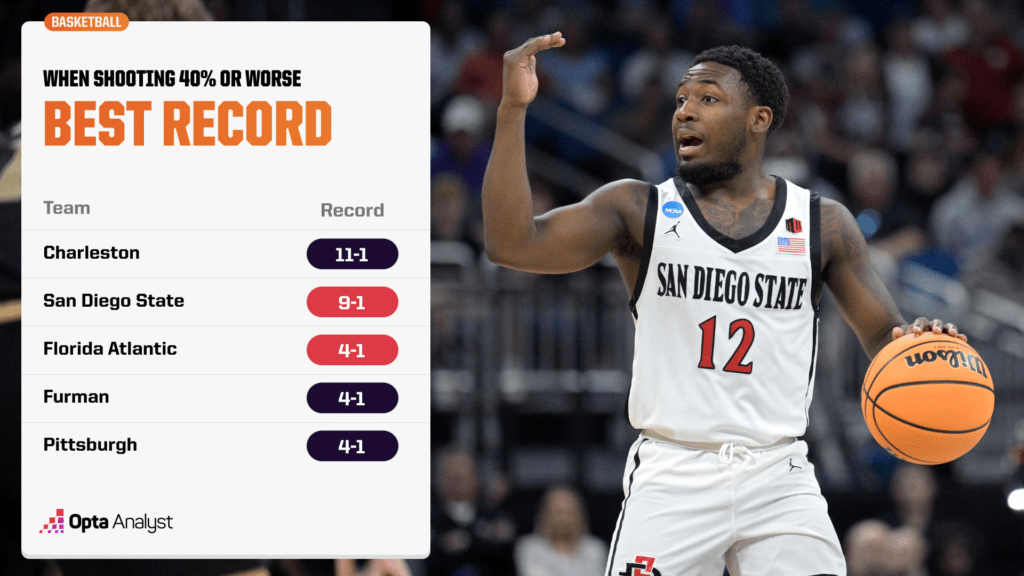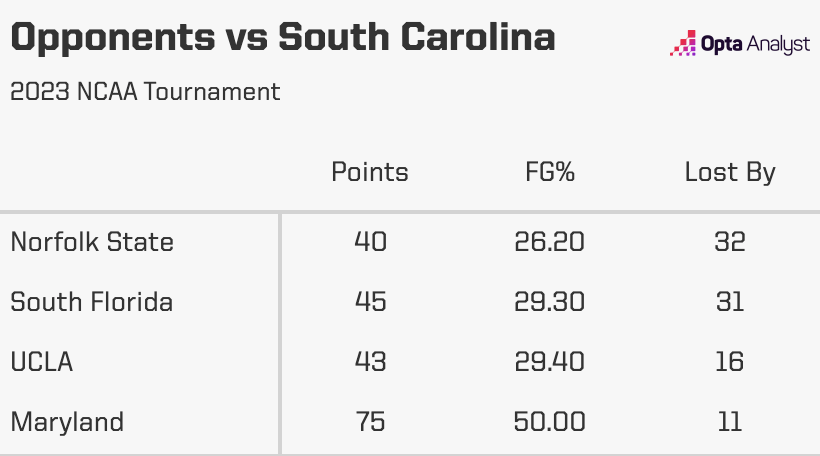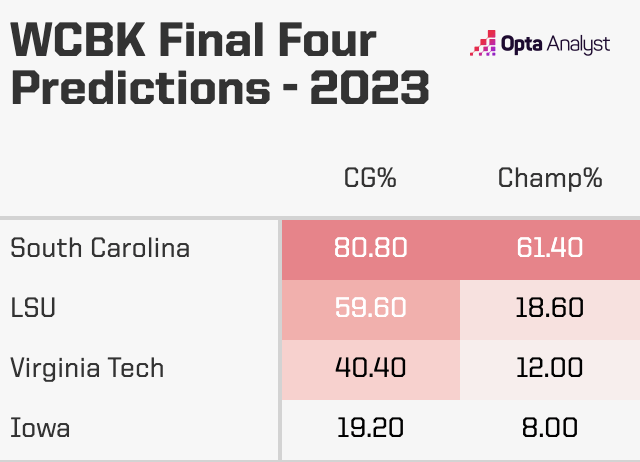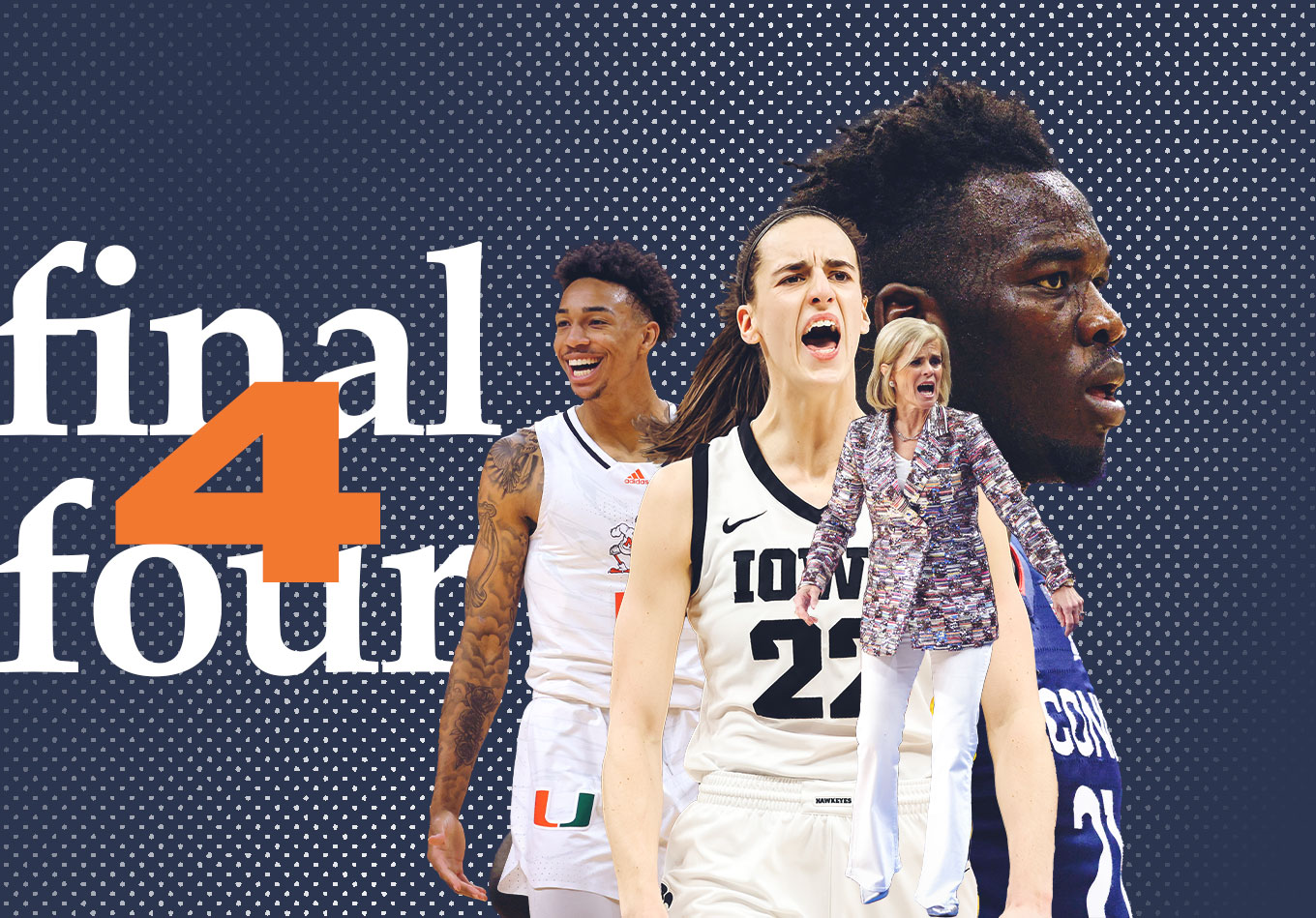OK raise your hand – who had this Final Four going into the tournament? Yeah, didn’t think so. I saw a few brackets on ESPN that had the top four – quite impressive! Personally, I was distraught on Sunday since I had both Creighton and Texas in my Final Four, but oh well. It is the first time ever where no Final Four teams are a top-3 seed. We are also guaranteed to have a mid-major in the championship game with the winner of San Diego State and FAU! Fun stuff.
Now, raise your hand if you have all four teams in the women’s Final Four. There might be a few of you if you followed TRACR, our Team Rating Adjusted for Conference and Roster. The four teams left had four of the five highest chances of reaching the Final Four, with the one exception being UConn. TRACR predicted South Carolina to have an 80% chance to get here. Told you these Gamecocks were special!
Now that the Final Four is set, what could happen? Let’s make the case for all 8 teams left in the NCAA Tournament, using TRACR. Recall that TRACR, which we also have for college football and women’s college basketball, is a net efficiency metric that calculates a team’s points per possession on both sides of the ball, adjusted by the team it plays. The model rewards teams that do well against good teams and punishes those that do poorly against weaker squads.
Let’s start with the easiest one on the men’s side:
The Case for UConn
UConn comes into the Final Four as the highest seed, but TRACR projected the Huskies as a 2 or 3 seed because of their talent. They are clearly showing that, winning all four games by at least 15 points, including a 28-point rout against Gonzaga in the Elite Eight.
Because of this run, UConn is now the best team in Division I, according to TRACR. UConn has a 70.7% chance to reach the final and a 50.4% to win it all. It is the favorite.
This should not be terribly surprising. Anyone that watched the Huskies in November and December knew that this was one of the best teams in the league. They are now 15-0 in nonconference play, outscoring opponents by an average of 25.5 points.
The last team to win its first 15 nonconference games while outscoring its opponents by more than 25 points per game was Kentucky in 2015. The Wildcats would go on to win their first 17 nonconference games before losing to Wisconsin in the national semifinal. Some argue that the 2015 Kentucky squad is the greatest team to not win the NCAA Championship.
Does that guarantee UConn losing to Miami? Of course not – of the six previous teams that reached such a feat over the last 30 years, four ended up winning it all – 2009 UNC, 2008 Kansas, 2006 Florida and 1994 Arkansas. Only Kentucky and Ohio State in 2011 missed the cut. UConn has a chance to join some historic teams.
But what does UConn need to do to win it all? First, it must continue with the superb 3-point shooting. The Huskies have shot 41.8% from beyond the arc in the tournament, making at least nine threes in every game. UConn is 19-3 on the season when making at least nine threes.
Sharing the ball has also been key for the Huskies, who have averaged 20.5 assists in the tournament. That spike in assists has been in part because of the rise of Andre Jackson Jr. He has tallied at least seven assists in all four games this tournament after entering the dance averaging 4.3 assists. He nearly had a triple-double against Gonzaga, posting eight points, nine rebounds and 10 assists.
The last player to record at least seven assists in his first four games of an NCAA Tournament game was Michigan’s Trey Burke in 2013 – Markquis Nowell also did this for Kansas State’s Elite Eight run this season.
Finally – Gonzaga showed that a team can kind of stop Adama Sanogo. Sanogo was held to 3-of-11 shooting in the Elite Eight, but still finished with 10 points, 10 rebounds and six assists. This line is still impressive, but not as impressive as the first three games where Sanogo averaged 23.3 points and 9.7 rebounds. Gonzaga still lost by 28.
Miami will have to stop Sanogo’s presence inside while disrupting UConn’s ball movement if it wants to win. While we’re on the topic…
The Case for Miami
Miami has been an incredible underdog, per TRACR. Entering the tournament, TRACR gave Miami just a 22.6% chance at reaching the Sweet 16 and a 2.8% shot to make it to the Final Four! That is the lowest among UConn (19.0%), San Diego State (7.4%) and FAU (4.9%).
The Hurricanes have played well down the stretch, but TRACR still was not buying their close wins in ACC play. They have turned it up at the best time.
How have they done it? Through second half determination, really. Miami was down late against Drake and was down by as many as 13 against Texas! The Hurricanes were up against Houston and Indiana at half, but both teams tied it midway through the second half. Miami was able to pull ahead at the end. Don’t let a halftime deficit fool you – the Hurricanes have outscored their opponents by 11.5 points on average in the second half this tournament.
Getting other opportunities has been key as well. Miami outrebounded Indiana, 48-31, including an astounding 20 offensive rebounds. It also kept its pace in rebounding against Houston, who outrebounded its opponents by an average of 7.2 rebounds. Miami will have to deal with UConn, who has outrebounded its opponents by an average of 9.4 rebounds, second in Division I behind Purdue (10.8).
When the team did not shoot well from three, it went to the line. The Hurricanes went 2-for-8 from three against Texas but went 28-for-32 (.875) from the free-throw line. That proved to be the deciding factor down the stretch.
Like it has all season, guard play has been the driving factor behind Miami’s success. Jordan Miller had 27 points in the regional final on 7-for-7 shooting and 13-for-13 from the line. The last player to go at least 7-for-7 from the field and 7-for-7 from the line was Christian Laettner in the 1992 Regional Final game against Kentucky. I wonder what his last shot looked like.
(Of course, that Duke team had Bobby Hurley, brother of Dan Hurley, so I’m sure we will see this during the Final Four broadcast.)
UConn can stop one guard, but can it stop two? Will it attack Miller or Isaiah Wong? Wong struggled against Drake but has been great since, averaging 20.3 points while shooting 47.5% from the field. Nijel Pack has also averaged 18.5 points this tournament. Can UConn go big and defend all of Miami’s guards, or will it play small and hope it does not get outrebounded? These are the questions Dan Hurley will have to answer.
The Case for San Diego State
Defense, defense, defense!!!
Opponents have shot 17.0% from beyond the arc against San Diego State this tournament. That is the second lowest allowed by any team through four games of an NCAA Tournament all-time. Only Syracuse in 2013 (15.4%) allowed a lower rate through four games.
The Aztecs held Alabama to 3-for-27 (.111) from three and Creighton to 2-for-17 (.118) from beyond the arc. If the Bluejays make one more, then San Diego State is out. Credit to the Aztecs for fighting.
When the game is played to the Aztecs’ style, they win. These low scoring games are nothing new – since February 15, San Diego State has averaged 64.8 points while holding opponents to 57.0 points per game. It is 11-1 in that time.
Can it keep up, though? San Diego State shot under 40.0% against both Creighton and Alabama. In NCAA Tournament history, teams are 308-1387 (.182) when shooting under 40.0% from the field. Still, the Aztecs have found a way for it to work, and they have played teams with a similar style.

Expect the battle of the mid-majors to be quite a fight.
San Diego State’s defensive TRACR ranks third in Division I behind only Tennessee and Alabama. The Aztecs were able to get by Alabama while Florida Atlantic was able to beat Tennessee. Who will prevail this time?
The Case for Florida Atlantic
Florida Atlantic’s run is the reason why this is the greatest tournament in sports. The Owls entered the tournament at 31-3 with most people having no clue who they were. They had to take Memphis to the final seconds to advance, then were graciously gifted with Purdue’s first round exit. After a second-half comeback against Tennessee and a back-and-forth game with Kansas State, Florida Atlantic makes the Final Four. Basketball!
This team is anything but a Cinderella, though. Florida Atlantic was ranked in the top 25 in both TRACR and the AP entering the tournament. The Owls are now 21st in TRACR. That is the lowest of the four remaining teams, but it is still close.
We have mentioned Miami’s dynamic offense and San Diego State’s lockdown defense. What’s nice about Florida Atlantic is that it is good on both ends of the floor. Its offensive TRACR stands at 11.8, which ranks 33rd in Division I and is ahead of San Diego State (8.6). Its defensive rating of -11.1 ranks 24th in Division I and is ahead of Miami (-5.4). UConn, however, is ahead of FAU in both categories.
The Owls have a better offense than the Aztecs – the question is whether they can get past SDSU’s defense. Well, they got past the number one defense in TRACR in Tennessee, so who says they won’t be able to get past another great defense?
FAU had to shoot better in the win over Kansas State and did. After shooting under 30.0% from three in its first three games, Florida Atlantic went 9-for-23 (.391) from beyond the arc against the Wildcats. However, the Owls committed a season-high 22 turnovers. They will need to make every possession matter against SDSU.
FAU also has the advantage of not needing to rely on one person – four starters scored in double figures against Kansas State. Nick Boyd, who had one of his worst games of the season against the Wildcats, has still been an X-factor, as shown with the ending of the Memphis game (on that note, how did I not choose a team who has a player named Boyd? Bad move on my part). TRACR sees the SDSU-FAU as a closer one to UConn/Miami – San Diego State has a 56.0% chance of reaching the final.
The Case for South Carolina
South Carolina has been by far the best team in Division I and looks to win its 43rd and 44th consecutive games dating back to last season en route to a second consecutive title. It had no problem reaching the Sweet 16, winning both games by more than 30, and it beat UCLA and Maryland by double digits to win the region.
Aliyah Boston has two double-doubles in this tournament and has recorded multiple blocks in all four games. Her incredible defense was part of the reason for South Carolina allowing 45 or fewer points in each of its first three games of this tournament. She is also the reason why the Gamecocks average 20.3 more rebounds over their opponents this season, by far the largest differential in Division I.
Brea Beal did it all against Maryland – 16 points, seven rebounds, five assists, three steals and two blocks. Only five other women since 2000 have put up such a line in the NCAA Tournament – UConn’s Breanna Stewart was the last to do it in a Regional Final.
Maryland did test South Carolina, however – look at how opponents have fared against South Carolina in this tournament:

While the first three opponents had no chance, Maryland did put up a fight by hitting threes and sharing the ball. The Terrapins were even up after the first quarter and shot better from both the field and from three all game! They still lost by 11 because they were outrebounded, 48-26, and they had too many players in foul trouble. They played a great game and still were out of luck against this Gamecocks squad.
If there was anything to fix for this South Carolina squad, perhaps it is at the line. The Gamecocks are 61-for-97 (.629) from the free-throw line this tournament. Maybe it just depended on who was at the line – Beal, for example, is a career 57.4% shooter at the line – but that could come up in a close game.
South Carolina was by far the favorite to win this thing entering the tournament, and it is still the favorite now. What a run. Buuuut….
The Case for Iowa
Did you see what Caitlin Clark did against Louisville in the Regional Final? A 41-point triple-double, the first in NCAA Tournament history. It’s mind boggling! This was against a tremendous defensive team in Louisville as well.
The way she is able to create space for herself is one thing, but the way she was able to spread the floor and dish to her teammates made this night even more special. Shades of Davidson’s Stephen Curry are in Clark. She has been clutch all season, too.
The best part is – she still has a year left of eligibility in the NCAA! She has also considered staying for a fifth season with the Hawkeyes using her eligibility from COVID-19. The best is yet to come.
Even South Carolina may have to double Clark, who is averaging 27.3 points, 7.3 rebounds and 8.6 assists on the season. Don’t rule out the rest of the team, though – McKenna Warnock has had a great tournament, averaging 12.3 points while shooting 54.8% from the field.
Warnock and Clark could outshoot the Gamecocks – Iowa has shot at least 40.0% from beyond the arc in five straight games. This should be a fun one.
The Case for LSU
Before we begin – good lord what has Kim Mulkey been wearing this tournament? If I may attempt my best Michael Kors impression, her outfit in the Elite Eight win over Miami was as if a flamingo vomited on the ugliest golfer jacket on the PGA Tour!
Perhaps her outfits are the reason why opponents are shooting 33.8% from the field and 23.2% from three against LSU in this tournament – Miami went 0-for-15 from beyond the arc against Mulkey’s pink feathers.
But this team is showing the committee that it had no place in being a 3-seed in the tournament and deserved a 1 or 2 seed. The Lady Tigers are 32-2, with losses to only South Carolina and Tennessee, and are the second best team in women’s TRACR behind the Gamecocks.
In many ways, this team is a lot like South Carolina. LSU outrebounds opponents by 16.0 per game, second best in Division I. The Lady Tigers draw fouls, averaging 20.6, and they can get to the line often. And when they turn up the heat on offense, boy do they – they opened the season scoring at least 100 points in each of their first five games. Their 54-42 win over Miami in the Elite Eight was the only time they scored under 60 points on the season, but it was the 12th time they held an opponent to 50 or fewer.
Angel Reese is the main player to watch, here. She averages 23.2 points and 15.7 rebounds, leading Division I with 32 double-doubles. She even had 25 points and 24 rebounds in the Round of 32 against Michigan. Is this Kim Mulkey’s new Britney Griner?
To win it all, however, the Lady Tigers need to shoot better. They are shooting 37.5% from the field in the tournament, including a poor 11-for-58 (.190) from three. LSU entered the tournament shooting 35.9% from beyond the arc. No matter how good the defense is, that shooting will not hold up against Virginia Tech and it surely will not hold up against South Carolina, who beat the Lady Tigers by 24 in February.
The Case for Virginia Tech
What a run it has been for the Hokies at the end of the season, running on a 15-game winning streak with almost every win coming by double digits. They knocked out a talented Tennessee team in the Sweet 16 while coming back to beat Ohio State to win the region.
How did they get here? Through experience.
This is not a team with depth, but the top eight players in terms of minutes are upperclassmen, seven of which are seniors. Virginia Tech gets 99.2% of its scoring from upperclassmen, highest in Division I. You might not see much of the bench, either – 80.3% of its minutes are by its starters this season, ninth in Division I.
The lack of a bench has been no problem for its starters. Elizabeth Kitley averages 18.2 points and 10.7 rebounds, and boy will it be fun to watch her match up against Angel Reese. Georgia Amoore’s 114 made threes this season are third in Division I behind Caitlin Clark and Ohio State’s Taylor Mikesell. Virginia tech has also gotten great minutes from Taylor Soule and Cayla King.
One thing the Hokies will need to do is stay out of foul trouble. LSU loves putting teams in foul trouble, and Virginia Tech had that same problem against Ohio State. King fouled out while Soule and Kayana Traylor were in foul trouble for much of the game. The lack of depth on this team makes it an issue.

